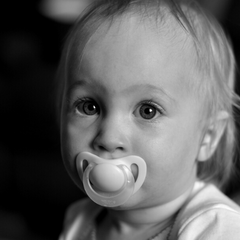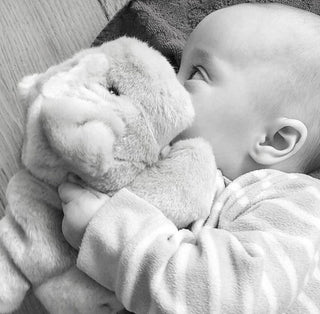We invited Anne Dumont, doctor, child psychiatrist and mother of two little girls, to discuss the subject of the comforter. What is it used for ? Is it so important? And other questions that we have all already asked ourselves as parents…

La Pelucherie : Hello Anne, in a few words, who are you?
Anne : I am Anne Dumont, doctor, psychiatrist, mother of two little girls aged 5 and 2. I was trained in the psychology of the child and the mother. The question of the cuddly toy is very much discussed by parents because it happens that children are very attached to their cuddly toy and sometimes this is not at all the case with children who do not have one at all! The question of the comforter can therefore raise many questions, and today I am here to answer them...
La Pelucherie : So, our first question would be quite simply: what is the purpose of the cuddly toy for a baby?
Anne : It's a security object first and foremost. An object of emotional security, but also something that allows the organization and construction of the baby's thoughts. This construction goes through an object, which is called transitional object and which makes it possible to make the link between the inner life of the baby, his feelings, his emotions, and the outside world. This object will allow him to apprehend the world with more ease, and to transform his affects, because emotions are very powerful in toddlers, much more than in adults. The cuddly toy helps regulate these emotions.
La Pelucherie : So that's why as soon as they have a little grief, babies catch it...
Anne : Indeed, since the cuddly toy structures thought and emotion, it allows the baby to feel more secure and to alleviate the different forms of anxiety that he encounters in the outside world. It is therefore an object that indirectly allows the child to explore the world around him. The comforter is in fact an object that guides the baby towards autonomy. It therefore becomes over time a security object, but originally it is a regulator of thought and psychic life... The cuddly toy is therefore much more important than we imagine! It allows the baby to represent the world. He is like a sesame allowing him access to the outside world. Because the world of the toddler is limited to his mom and dad. The comforter is therefore the object that facilitates the transition from the world of parents to the outside world.
La Pelucherie : When my children have a little grief, I give them their cuddly toy right away to reassure them, is this a good practice?
Anne : Yes, because I think it's an object that should always be available to the baby. In any case, the comforter is like an extension of the baby, so he will grab it when he feels the need. In fact, it is more precisely an object that is both an extension of the toddler and that of the mother. So whether mum or dad gives it to the baby is not a problem. On the other hand, parents must also be available to reassure baby. The cuddly toy is not an excuse to run away from baby's grief (Laughs).
La Pelucherie : Can we intervene in the choice of the cuddly toy?
Anne : The baby needs choices but also to appropriate the object that he has identified as his own. I think it is necessary to offer several cuddly toys to the baby and then the child will choose his own cuddly toy. It can be a more or less flat object, a stuffed animal, a small character that will not necessarily be an animal. There are babies who love to have a little thread to pull, a little piece of wool to suck on, or labels to chew on. We'll have to see what the baby needs. But on the other hand, don't give him just one blanket! He must be spoiled for choice and he is the one who chooses his style of cuddly toys! It's a bit sad to start his life that the baby has no choice, so it is better to favor several models so that the child can select his favorite cuddly toy.
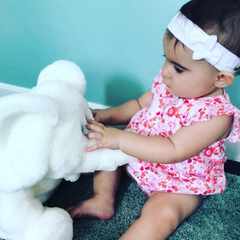
La Pelucherie : A question that often bothers parents is that of going out: can the child go out with the cuddly toy?
Anne : The child must also be able to choose whether or not to take his cuddly toy with him when he leaves the house, since it is an object that can have a very important emotional function. Of course, the child will gradually detach from his cuddly toy. Everything is different for a child of 2 years old and a child of 5 or 6 years old who starts going to school and will have a different use of it. Where the child of 2 years will be more likely to take it everywhere with him, the child of 5 or 6 years will not necessarily be bothered to find it only in the evening, after school. So the use of the cuddly toy evolves with age: it is very progressive and it is quite natural! A cuddly toy is an object that we do not have to mourn: the separation of the child and his cuddly toy is gradual and happens naturally.
La Pelucherie : (Laughs) For my part, I had a tendency, I admit, not to let the cuddly toy out of the house because I was afraid that my child would lose his cuddly toy. So I gave him a substitute when we left the house so that he still had something to hold on to...
Anne : But the problem is that the child is not fooled (Laughs). It is better to anticipate and be an organized mum, that is to say, keep several copies of the fetish cuddly toy in advance. You should always have a spare cuddly toy in the suitcase, for example – but be careful that the baby doesn't see it, because he could then take the two cuddly toys each time you move (Laughs)! It is not necessary to have an exponential quantity of cuddly toys, but enough spare cuddly toys to be able to be sure that if baby loses his cuddly toy, he will not be traumatized.
La Pelucherie : Washing the cuddly toy is always a tragedy...
Anne : If there is a spare, there is not necessarily a drama. The difficulty is rather to identify the right time to wash the comforter.
La Pelucherie : And when does a child choose his cuddly toy?
Anne : The choice is generally made at the age when the baby can grab his cuddly toy, so most often around 4/5 months. Instinctively, babies will want to take a cuddly toy if one presents them with one in their field of vision. The child's precursor gestures can also be good indicators: the baby sucks his thumb, sucks on the end of a sheet, puts his fist in his mouth, etc. These attitudes are transitional. Thereafter, toddlers will be able to adopt auto-erotic practices or activities that will help to soothe them: a baby who tends to rock in his bed, the gesture of touching his hair, all these gestures will allow relief in the child.
La Pelucherie : And so, from 4-5 months, is it serious if my child still doesn't have a cuddly toy?
Anne : It's rare but it's not pathological. In reality, the little one may have found ways to create a transitional zone without a comforter. For example, there are mums or dads who become cuddly toys for children. We must exonerate parents who have children without comforters. The only difference is that they will be much more stressed in the transition periods of the little one, for example during the moment of falling asleep. They will therefore have to be extra careful, because these children will often ask to be comforted more than the others, since they will have invested their parents as cuddly toys. If you realize that your child is more anxious than others because he tends to cling more to you, it is not pathological. What matters is to find solutions so that the child is not in pain and neither are you. But it also very often provides information on the emotional profile of the parents, and on how they managed their attachment ties when they were young. Often, parents who become cuddly toys have managed to sleep alone later, have encountered problems to be reassured when young, etc. But there can of course also be exceptions…
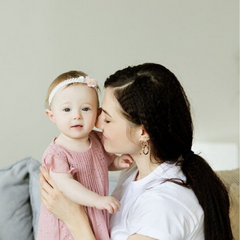
La Pelucherie : Isn't there an age to let go of your cuddly toy either?
Anne : There is no age in the sense that the cuddly toy is there to soften the moments of transition, so it is also there to become an adult. The comforter which has a function of symbolization will bring the child towards the imaginary life and the structuring of his thoughts. He therefore accompanies the child towards things that will encourage him to separate from him, such as art, culture, imaginary life. Because all these activities make it possible to part with the cuddly toy. And even so, there are always situations where someone may need to go back to their comforter. In times of crisis like the one we are going through right now, some adults may feel the need to take back their baby comforter. More generally, for people whose transitional period has not been fully completed, the need to return to the object of the cuddly toy can arise quite often.
La Pelucherie : So as parents, we have to accept everything from the cuddly toy…
Anne : Yes, that's right, as a parent, I think we have to tolerate that the security blanket is dirty, that it smells bad, and sometimes even that it is ugly (Laughs)! And if it's too clean and the baby doesn't want to take it, I advise the mum to sleep with it in her nightgown so that the cuddly toy takes on her scent and is more easily accepted by the baby.
La Pelucherie : If you can't buy the same cuddly toy, how can you help the child find another cuddly toy?
Anne : I have already been confronted with this situation, and we managed to redeem the famous cuddly toy three years later. So for my second daughter, we were more forward-looking and we bought her favorite cuddly toy in five copies. Normally, therefore, we are quiet (Laughs)! There is one who is at the crèche, one who stays with the grandmother, and if she loses one there will always be another to spare.
La Pelucherie : For my first daughter, I had bought the same cuddly toy twice, but as she had already invested in the first copy, she never wanted the second. So does that mean that we should alternate between the copies of the cuddly toys from birth?
Anne : Yes, for example when one of the cuddly toys is in the dirty, the other takes over, to rotate between the copies from the start and not confuse the baby. In fact, you can always manage to change the cuddly toy, but it will never be the same attachment as with the child's original cuddly toy, that is to say the one that has accompanied him since birth.
La Pelucherie : I have the impression that the comforter is a new phenomenon, when we were little this object was less important...
Anne : In the 1980s, there were stuffed animals and nin-nins, that is to say comforters in the form of sheets. We still have them today, but they are of course less cute than some of the cuddly toys that are currently on offer. Today, perhaps we pay more attention to comforters because we are very attentive to the needs of the child, more than before. In the 1930s/1950s, for example, it was believed that the baby did not suffer and had no nervous system. As a result, babies were operated on without anesthesia. Today, we are much more aware that the baby is a whole person. So we are more focused on baby objects, including the cuddly toy, than previous generations. Which could explain why they were given more varied appearances, with color, materials, etc.
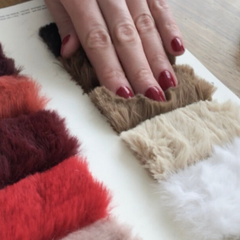
La Pelucherie : Is it worrying if a child doesn't have comforters?
Anne : A child is immature, on all levels: reflexive, emotional, etc. He will therefore always need outside help to calm down. And for that, he needs an object like the cuddly toy or a person, like the mom, the dad, or a grandparent etc. So you shouldn't get sick if your child doesn't have a cuddly toy. On the other hand, we must ask ourselves why we are the only person who can appease him.
La Pelucherie : My son is 9 years old and has trouble detaching himself from his cuddly toy. But he is afraid that people will make fun of him at school because he keeps it. What to do ?
Anne : You shouldn't worry too much, just find other occupations that could soothe her, such as creative activities, theater. Rather favor, therefore, activities where its expression is valued.
La Pelucherie : As a parent, you must therefore always accompany your child with his cuddly toy. And discreetly provide him with help through activities that will promote his transition to detachment from the cuddly toy.
Anne : Exactly, you will have to gradually lead him towards activities that will help him gain self-confidence and be able to face the outside world without his comforter. It is therefore necessary to know which activities to mobilize to help stimulate his imagination. For some children, it can be creative and artistic activities, for others sports activities, so it all depends on the child's interests.
La Pelucherie : Is it serious if an adult keeps his cuddly toy?
Anne : No, I don't think it's serious. It's completely normal, but you have to see if behind this need to preserve the security blanket there isn't some fear of the outside world, perhaps a form of social phobia.
La Pelucherie : Some cuddly toys are very large and others are small, is it a coincidence or a matter of opportunity?
Anne : It's a question of opportunity, but you still have to keep in mind that we have to be able to send him on a trip!
La Pelucherie : What to do when the cuddly toy is a pacifier and baby has trouble getting rid of it?
Anne : The pacifier is not considered a security blanket by child psychiatrists. To be able to part with it, I advise you to consult a dentist or an orthodontist so that he can offer you an adequate solution.
La Pelucherie : Can a child change comforter along the way?
Anne : Of course, as long as it's a natural, spontaneous and uninfluenced choice, it's entirely possible!
La Pelucherie : We've covered all the questions! A big thank you Anne for all these details. Next meeting: the cuddly toy in a crisis situation!
